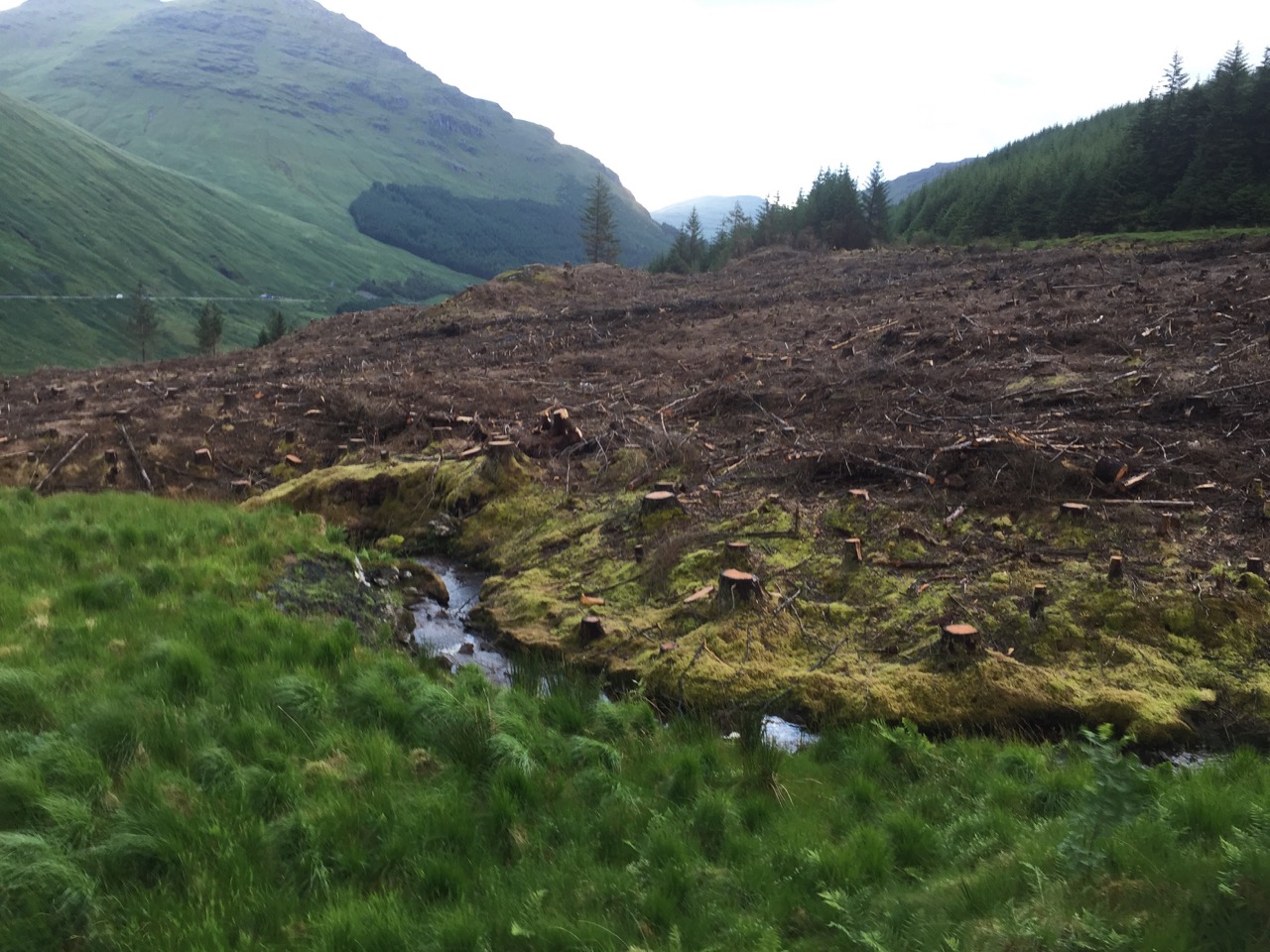
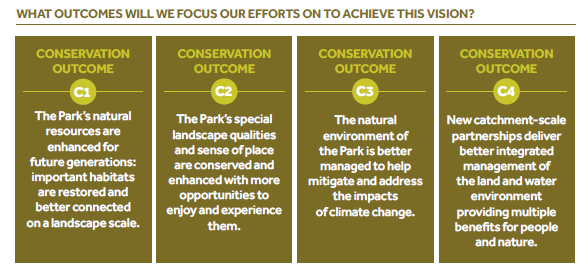 This post looks at the Conservation and Land Management section of the draft Loch Lomond and Trossachs National Park Partnership Plan (NPPP) which is out for consultation until 3rd July (see here). It argues that the Outcomes (above) in the draft NPPP are devoid of meaningful content, considers some the reasons for this and outlines some alternative proposals which might go some way to realising the statutory conservation objectives for the National Park.
This post looks at the Conservation and Land Management section of the draft Loch Lomond and Trossachs National Park Partnership Plan (NPPP) which is out for consultation until 3rd July (see here). It argues that the Outcomes (above) in the draft NPPP are devoid of meaningful content, considers some the reasons for this and outlines some alternative proposals which might go some way to realising the statutory conservation objectives for the National Park.
Conservation parkspeak
Call me old fashioned but I don’t see why the Loch Lomond and Trossachs National Park needs a vision for conservation – “An internationally renowned landscape where nature, heritage, land and water are valued, managed and enhanced to provide multiple benefits for people and nature” – when it has a statutory is duty a) “to conserve and enhance the natural and cultural heritage of the area” and b) to promote sustainable use of the natural resources of the area. The statutory duty to my mind is much simpler and clearer, the vision just marketing speak.
Indeed, the draft National Park Partnership Plan is far more like a marketing brochure than a serious plan. This makes submission of meaningful comments very difficult. Feel good phrases such as “iconic wildlife”, “haven for nature”, “stunning and varied wildlife”, “vital stocks of natural capital” are peppered throughout the document. The reality is rather different, but you need to go to the Strategic Environmental Assessment (SEA) to find this out:
- The Park has 27 designated sites assessed as being in “unfavourable” condition due to grazing pressures
- Three river and 12 loch waterbodies in the Park still fail to achieve “good” status in line with Water Framework Directive (WFD) objectives.
- The Park has 25 designated sites assessed as being in “unfavourable” condition due to pressures from Invasive Non-Native Species.
In other words progress during the period of the 2012-2017 Plan has not been what one might have expected in a National Park. Instead of trying to learn from this and set out actions to address the issues, the LLTNPA is trying to bury failures under the table and to conceal its lack of a clear plan with marketing speak. There is no need to take my word for it, the problems are clearly spelled out in the SEA:
The main weakness of the new plan over the extant plan is its lack of specificity combined
with its with its very strategic nature: given limited resources and the framing of the priorities in the draft plan, it is unclear how intervention will be prioritised. For example, in the extant NPPP [2012-17], waterbody restoration and natural flood management measures are focussed in the Forth and Tay catchments. The new plan does not appear to include any such prioritisation and it is unclear if there will be sufficient resources to deliver the ambitious waterbody restoration measures across all catchments during the plan period. This key weakness is likely to be addressed by using the new NPPP as a discussion document to formalise arrangements and agreements with partner organisations on an individual basis (e.g. using individual partnership agreements as per the extant NPPP). However, it would be preferable if resource availability (and constraint) is articulated clearly in the plan document to help manage expectations;
Or, to put it another way, the NPPP outcomes are so “strategic” as to be meaningless, the LLTNPA has failed to consider resource issues and is planning to agree actions in secret with partner bodies once the consultation is over. It appears that all the failures in accountability which took place with the development of the camping byelaws (developed in 13 secret Board Meetings) will now apply to conservation.
Economic interests are being put before conservation
This failure in governance – about how plans should be developed – conceals a skewing of the National Park’s conservation objectives towards economic interests (in spite of the duty of the LLTNPA, under the Sandford principle and section 9.6 of the National Park (Scotland) Act to put conservation first). The best example is the beginning of the conservation section where the LLTNPA outlines the main threats to the “natural environment” the Park faces:
- Impacts on freshwater and marine water bodies from problems such as pollution from surrounding land uses [ e.g algal blooms in Loch Lomond];
- Unsustainable levels of wild and domesticated grazing animals in some upland and woodland areas, leading to reduced tree cover and the erosion of soils, which are important carbon stores [the 27 sites according to the SEA];
- The spread of invasive non-native species which displace our rich native wildlife; [we are given no indication of how much progress has been made tackling this over last 5 years]
- The impacts of climate change leading to warmer, wetter weather patterns and a subsequent
increase in flood events, major landslides and rapid shifts in natural ecosystems.
Omitted from this list are the many threats to the landscape of the National Park which is being destroyed by “developments”: Flamingo Land, the Cononish Goldmine, transport routes and over 40 hydro schemes with all their associated tracks.
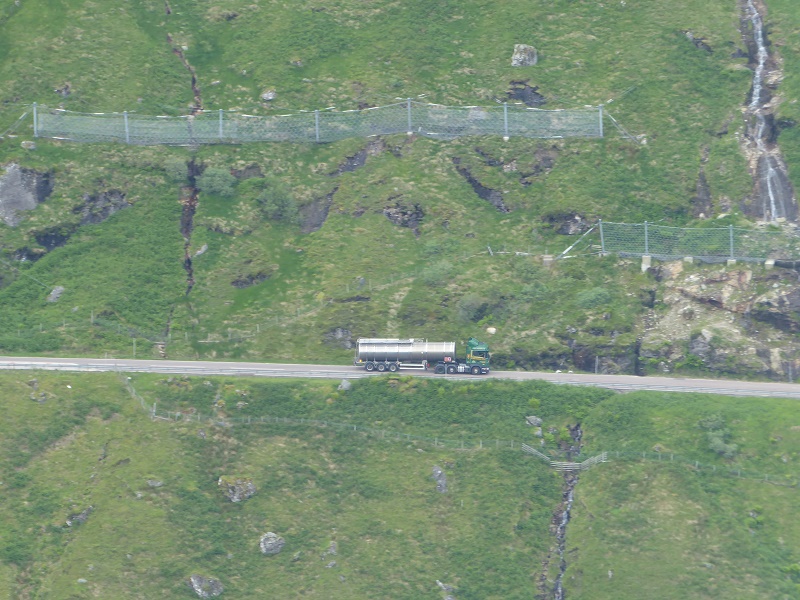
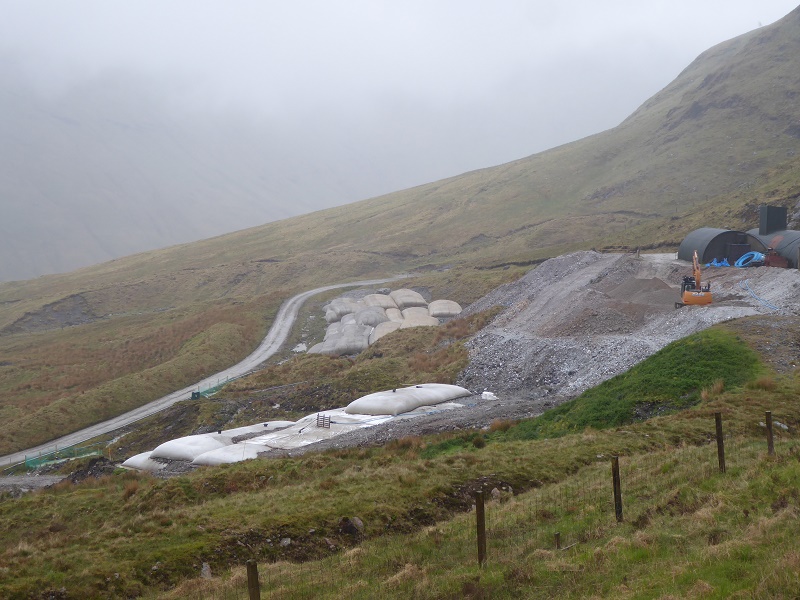

In the world of parkspeak however all these developments will be classed as successes. The reason? One of the measures of success is “Planning & Development: The percentage of the Park and/or number of sites with landscape mitigation schemes”. The developments in the photos above have all been “mitigated” by the Park as Planning Authority – an “unmitigated bloody disaster” would be a more accurate description of what the LLTNPA is allowing to happen.
Many of these developments also impact on the ecology of the National Park. For example, despite all the fine words about water catchment planning and flood prevention there is NO consideration of the impact of the 40 plus hydo schemes being developed in the National Park on flooding (send the water through a pipe and it will descend the hill far more quickly than in a river) or the ecology of rivers.
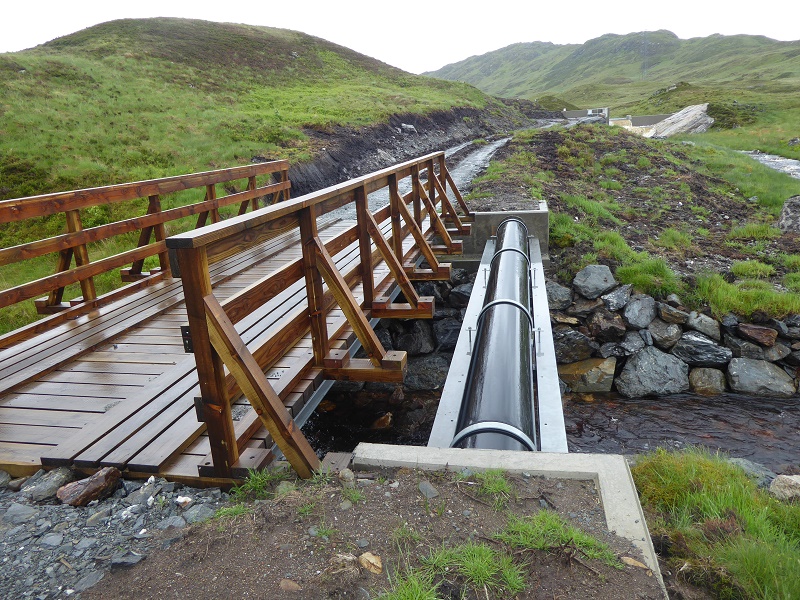
A more specific example is conservation Priority 11 which says the LLTNPA will “Support for land managers to plan and deliver multiple environmental and social benefits, alongside economic return, through the creation and delivery of Whole Farm and Whole Estate Management Plans”. This is the same LLTNPA which, while claiming 28% of the National Park is now covered by such plans, has recently refused to make them public on the grounds they are commercially sensitive(see here). If this is not putting commercial before conservation interests, I am not sure what is.
The few specific “conservation” objectives are not about conservation at all

While there are very few specific conservation objectives in the NPPP, those that do exist are clearly driven by other agendas
Conservation Priority 4
Supporting projects that enhance opportunities to enjoy landscapes particularly along major transport routes and around settlements and also that better meet the different travel mode needs of visitors, communities and businesses. Priorities include:
– Implementing a strategically planned and designed upgrade to the A82 between Tarbet and Inverarnan;
-Continuing to review landslip management measures on the A83 at The Rest and Be Thankful.
Landscape conservation has been reduced to ensuring that people can enjoy the view from the road. There is no consideration on the impact of those roads (visual, noise etc):
It is important that we ensure that key areas of the Park where people experience the inspiring vistas found here are recognised and enhanced. This means that key transport routes, such as trunk roads and the West Highland railway line, along with the settlements in the Park, continue to provide good lines of sight to the stunning views of the iconic landscapes found here.
Biodiversity in the National Park
The new NPPP actually represents a considerable step backwards from Wild Park 2020 (see here), the LLTNPA’s biodiversity action plan, which is not even referred to in the NPPP. The vision set out in Wild Park (P11), which is about restoring upland and lowland habitats, enriching food chains (to increase numbers of top predators) woodland re-structuring etc, is worth reading – a far clearer and coherent vision than in the NPPP. That should have been the NPPP starting point.
Wild Park contained 90 specific actions, which were due to be reviewed in 2017 – “the Delivery and Monitoring Group will undertake a mid-term review in 2017 of progress overall on the projects and programmes in Wild Park 2020” . There is no mention in the NPPP about what has happened to that when it should have been central to developing the new plan. Part of the problem is the LLTNPA has taken very little interest in conservation over the last three years – there are hardly any papers to the Board on conservation issues as all its focus and the Park’s resources have been devoted to camping management.
The weakness in Wild Park was that while it included many excellent projects, these were mostly limited to small geographical areas and many were located on land owned by NGOs (eg a significant proportion of all the projects were located on NTS land at Ben Lomond and the Woodland Trust property in Glen Finglas). There was nothing on a landscape scale and very few contributions from Forestry Commission Scotland, by far the largest landowner in the National Park. The draft NPPP claims (under conservation outcome 1) to want to see conservation on a landscape scale but contains no proposals about how to do this apart from setting up a network of partnerships. This begs the question of why these partnerships will now work when we know over the last 15 years similar “partnerships” have failed to address the main land management issues which affect landscape scale conservation in the National Park, overgrazing and blanket conifer afforestation.
What needs to happen – biodiversity
First, the LLTNPA needs to have some ambition. On a landscape scale this should include a commitment to a significant increase increase in the proportion of forestry in the National Park which is managed in more sustainable ways. The SEA describes this as “there is an opportunity and interest in increasing the amount of woodland under continuous cover forestry (CCF) systems. This would reduce the amount of clear fell and associated soil erosion and landscape impacts”. So, instead of failing to mention the Argyll Forest Park, why is the LLTNPA not pressing the FCS to change the way it manages forestry there? How about aiming to convert 50% of that forest to continuous cover forestry systems over the next 10 years?
And on a species level, there is no mention of beavers in either the NPPP or SEA. Amazing the lack of join up:
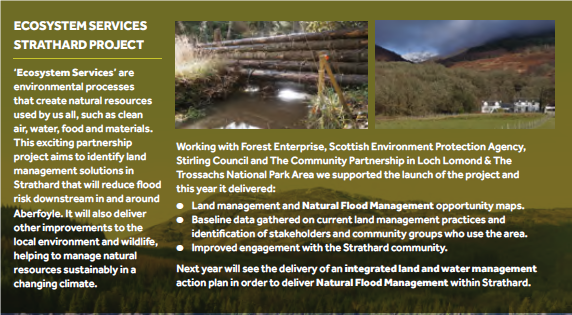
Wild Park described one indicator of success in 25 years time would be that “The Tay catchment beaver population has expanded into the National Park at Loch Earn and Glen Dochart and is managed sympathetically to prevent damage to fisheries and forestry production, whilst also providing a significant new attraction to tourists and habitat benefits such as coppicing and pond creation in acceptable locations.” The LLTNPA should bring that forward and actively support beaver re-introduction projects now.
Second, there needs to be some far more specific plans (which the Park should have consulted on as part of the NPPP to guage public support) which are both geographical and theme based. Here are some examples:
- So, what exactly is the plan for the Great Trossachs Forest, now Scotland’s largest National Nature Reserve, which is mainly owned by NGOs? (You would have no idea from the NPPP).
- How is the LLNPA going to reduce overgrazing?
- What about working to extend the Caledonian pine forest remnants in Glen Falloch (which would also hide some of the landscape scars created by hydro tracks)?
- What does the LLTNPA intend to do to address the widespread persecution of species such as foxes in the National Park?
- What can the National Park do to address the collapse of fish stocks in certain lochs or the threats to species such as arctic charr (whose population in Loch Earn is under threat from vendace).
I hope that people and organisations responding to the consultation will add to this list and demand that the LLTNPA comes up with a proper plan for the next five years and argue for the resources necessary to deliver such objectives.
What needs to happen – landscape
First, the LLTNPA needs to start putting landscape before development and state this clearly in the plan. There should be no more goldmines, large tourist developments (whether Flamingo Land or on the torpedo site at Arrochar) and improvements to transport infrastructure (which are needed) should not be at the expense of the landscape. Tunnelling the A82 along Loch Lomond – which has been discounted by Transport Scotland as too costly – should be put back on the agenda.

Second, I would like to see the LLTNPA have a bit of ambition and make an explicit commitment to restoring historic damage to landscapes. What about burying powerlines as is happening in English National Parks (there is one small initiative at present in the LLTNP)? How about restoring damage to the two wild land areas on either side of Glen Falloch, particularly the old hydro infrastructure south of Ben Lui, the largest area of wild land in the National Park?
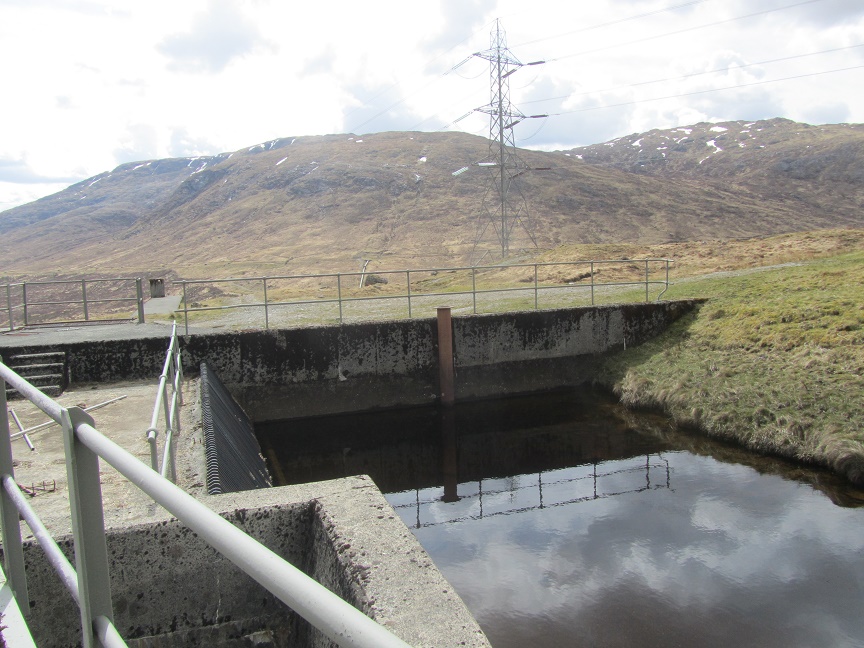
The LLTNPA Board should also commit to a complete review of how it has managed the impact – “mitigated” – the construction of hydro schemes, engaging the people and organisations who have an interest in this. The big issue here is the hydro construction tracks, which the LLTNPA now allows to remain in place, and which have had a massive deleterious affect on the more open landscapes in the National Park. The LLTNPA’s starting point in the new NPPP is that there should be a presumption against any new tracks in the uplands and therefore that all hydro construction tracks should be removed in future. There should be a review of the tracks which have been agreed over the last five years and a plan developed on how these could be removed (the hydro scheme owners, many of whom are based in the city, are not short of cash and could afford to do this – that would be a demonstration of real partnership working).
Finally, as part of any plan to restructure conifer forests in the National Park, the LLTNPA also needs to develop new landscape standards for Forestry which should include matters such as track construction and felling. There should be a presumption against clearfell.
What needs to happen – resources
Just like the Cairngorms NPPP, the LLTNPA NPPP makes no mention of resource issues. Instead, the underlying assumption behind the plan is neo-liberal. The state should not provide – in this case the National Park cannot expect any further resources – and the priority of government is to enable business to do business, which (according to the theory) will all some benefits to trickle down to the National Park.
This is totally wrong. We need a proper plan which sets out what needs to be done, how much this will cost and how this will be funded. The Scottish Government could of course and probably would say “no” but things are changing politically and proper financing of conservation (and well paid rural jobs) are key to the third part of the NPPP which is about rural development.
Thanks for reminder re Consultation deadline and the piles of useful amunition.
Great article Nick, it gets to the very heart of the matter it’s not a plan at all, a collection of boilerplate text and images showing past achievements that have at best, tenuous links to the National Park. The criteria for a national park success story is that some other agency has carried out good work in the park boundary and by association the National Park take credit for it. Pulpit Rock is a prime example while just down the road we are back to one lane and traffic lights after the recent jack knifed lorry incident, all that money and we still have to queue, the Park Authority doing nothing as the holiday season ramps up.. The priority for everything in the park is development, unwarranted development in a national park. The Park Board have failed to maintain the conservation aims the National Park was created to champion instead diminishing the park to the same status as the rest of Scotland by associating the Park future with the 2016 -2017 A Plan for Scotland, a document that will be obsolete before the NPPP even comes into force. The truth of the matter is business interests have been given priority over everything, but it is the underhanded way in which the park have achieved this, in secret, at closed meetings and through deception.
The current Park Authority and Planning authority need to be brought to task on these issues and they should start with this NPPP 2018 -2023 and get some real deliverables and outcomes stated with dates during the plan lifetime not just “by 2023” and budgets to demonstrate how they will be achieved. But before doing even that they need to set out past achievements and failures so we have a baseline to measure future performance. We are going from year to year without proper reporting merely marketing other agencies achievements as their own while the main work of the Park Authority as a commercial development organisation goes on unhindered in the background.
Hi Nick
I enjoyed your article and share many of the same views. May I use the photos of Glen Croe for my own posting about inappropriate forestry operations. I have been promoting for some time the need for more native woodland planting to help mitigate the risks of landslips, in particular native aspen which we grown in our nursery. We have a ridiculous situation where one side of the glen is bare and suffering erosion and on the other subject to commercial forestry clearfell creating massive visual intrusion.
thanks
Peter Livingstone
Eadha Enterprises
Peter, delighted other people are highlighting poor forestry practices. I am quite happy for any of my photos on parkswatch (they are the uncredited ones) to be used for non-commercial purposes. Where a photo is credited, it means it was taken by someone else, and I need in those cases to check with them first. Nick